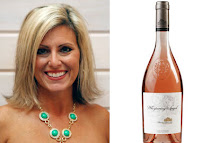In the constant quest for healthy, weeknight meals that require a minimal amount of time and effort, here's another Fast & Fabulous recipe I'd like to share with you!
This Red Curry Chicken Stir Fry was inspired by some of my favorite Asian flavors including spicy red curry; rich, creamy coconut milk; and freshly grated ginger. The shiitake mushrooms, chopped peanuts and dark meat chicken also add delicious texture to the dish that really keeps you coming back for more (Steve will happily vouch for that).
If you're in the mood for wine (c'mon, you know you are), a white wine with a hint of sweetness like Pinot Gris or Riesling will work nicely to complement the flavors as well as keep the heat in check. If you're in the mood for red, however, give a light, fruity Beaujolais a try.
I hope you enjoy this dish and for other recipes in the Fast & Fabulous series, please go to the top, left-hand side of this page and enter "Fast and Fabulous" in the search box. Then simply select from the delicious results and enjoy!
Cheers,
Red Curry Chicken Stir Fry
Serves 2-4
3 Tbs. peanut oil
1 carrot peeled and thinly sliced
8 ounces green beans, trimmed and cut into bite size pieces
2 Tbs. plus 1/4 cup chicken stock
2 garlic cloves, minced
1 Tbs. peeled and grated fresh ginger
2 Fresno chiles, sliced
2 Tbs. prepared red curry paste
6 boneless, skinless chicken thighs cut into 1/2 inch pieces
1/2 cup coconut milk
8-10 shiitake mushrooms sliced
2 scallions sliced, green and white parts separated
1 Tbsp. fish sauce
Salt and pepper
Salt and pepper
1/4 cup cilantro, for garnish
1/2 cup chopped peanuts, for garnish
Directions:
Heat 1 Tbsp. peanut oil in skillet over high heat. When oil starts to smoke, add green beans and carrots and stir fry for 1 minute. Add 2 Tbsp. chicken stock to facilitate cooking and stir fry for another minute. Transfer to plate and set aside.
Wipe out the pan and return to heat. Add the remaining 2 Tbs. peanut oil and heat over med-hi heat. Add the garlic, ginger and half the chiles and stir fry for about a minute. Add the red curry paste and stir fry for 1-2 minutes. Add the chicken and stir fry until chicken is browned, 3-4 minutes. Add the coconut milk and cook for an additional minute. Stir in the remaining 1/4 cup chicken stock, shiitake mushrooms, light parts of the scallion, and fish sauce and cook until the chicken is cooked through, 1-2 minutes more. Add the green beans and carrots back to the pan and season with salt and pepper to taste. Transfer to a serving plate and garnish with the chopped cilantro, green parts of the scallion, remaining chiles and chopped peanuts. Serve over white or brown rice.

































